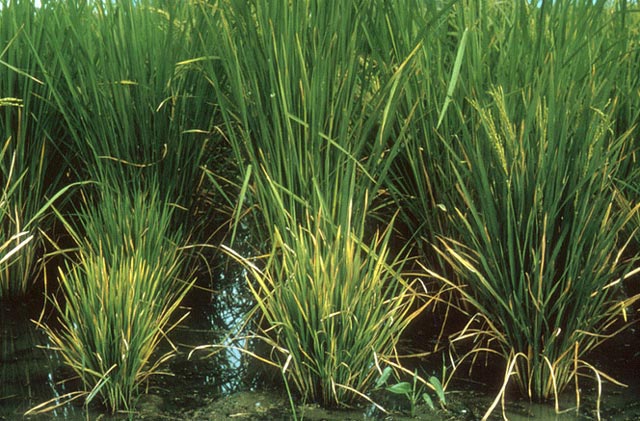Rice grassy stunt
 What it does
What it does
Rice grassy stunt virus reduces yields by inhibiting panicle production.
Why and where it occurs
Rice grassy stunt virus affects rice crops in areas where continuous and year-round rice growing is practiced.
The virus is transmitted between plants by insect vectors. Nymph and adult stage plant hoppers are common vectors for rice grassy stunt virus. The plant hoppers need to feed on an infected plant for at least 30 minutes to pick-up the virus.
Plants can be infected at all growth stages. They are most vulnerable to infection at the tillering stage. Rice grassy stunt virus symptoms develop 10−12 days after infection. Infected stubble and volunteer rice are sources of rice grassy stunt virus. It cannot be transmitted via brown planthopper eggs.
How to identify
To identify hills of Rice grassy stunt virus-infected plants check for the following symptoms:
- severely stunted plants
- excessive tillering
- very upright plant growth
- grassy and rosette appearance of plants
- yellowish green leaves that are shorter and narrower than normal
- leaves that remain yellow even after application of sufficient nitrogen fertilizers
- numerous small rusty spots or patches on leaves, which merge into blotches
- leaves have a mottled appearance
- plants that fail to produce panicles
The stunting and excessive tillering symptoms of rice grassy stunt can be confused for symptoms of rice yellow dwarf and rice dwarf disease. To confirm Rice grassy stunt virus, check for grassy or rosette appearance of plants and prominent rusty spots on the leaves.
Why is it important
Generally rice grassy stunt virus occurrence is not widespread. The disease can become a serious problem of limited rice growing areas when there are brown planthopper outbreaks.
How to manage
To control rice grassy stunt virus the brown planthopper vectors need to be managed. This can be done either through the use of insecticides, brown plant hopper-resistant varieties, or synchronized crop establishment. Infected stubble needs to be plowed under after harvest to reduce the virus source.







